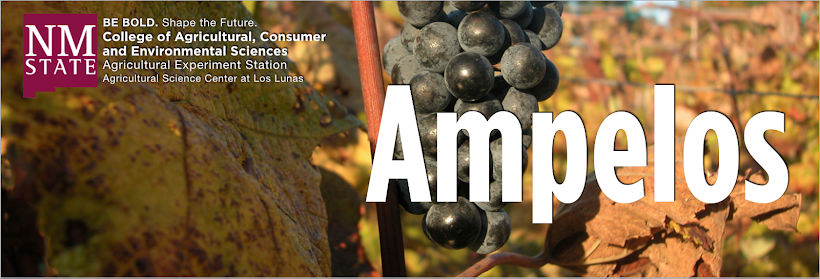October 14, 2019 | Written by: Gill
-
Leaf senescence: “planned death”, signals the
growing season end for temperate zone plants (https://www.hunker.com/12003940/flowers-plants-found-in-temperate-forests)
inclusive of grapevines. Leaves contain the green pigmented compound
chlorophyll, that is directly active in photosynthesis. Photosynthesis (Pn),
the process that transforms light energy, CO2, and H2O to chemical energy, O2,
and H2O is fundamental to life as we know it. Pn uses visible spectrum light
waves from about 400 nm (blue) to about 700 nm (red). Grape leaves absorb most
of the damaging UV light, but are transparent to visible light. Photosynthesis does
not use light wavelengths that are very short (<400 nm, ultraviolet) or very
long (>700 nm, infrared).
- Age matters. Young and old leaves are not as
effective at Pn as are ‘middle aged’ leaves, that is, leaves that are about 40
days old. Younger leaves are not fully functional and older leaves in the
process of breaking down, are not as photosynthetically efficient.
o
“So, what?”, you might say, but photosynthesis
is important to savvy winegrowers, because Pn, light, and leaves impact the
yield and quality of your wine. Berry composition and wine “quality” depends on
vine health and canopy management. To effectively manage your vine’s canopy,
some knowledge of leaf physiology…or “the life of the leaf” is useful.
-
Light directly affects a grapevine in several
ways:
o
Light impacts grape berry composition (color,
flavor and aroma),inflorescence initiation and fruit set, incidence of disease and
cane maturation (formation of periderm and lignification).
o The
thing to keep in mind, especially in sunlight rich New Mexico, is that a green
plant’s leaves use no more than ~5% of the incident sunlight. Five percent
would be an amount we would normally dismiss, if not for life’s total
dependence on that 5%!
Nonetheless, the
other 95% makes trouble, as it can lead to excessive heat (Figure 1).
 |
| Figure 1. Chardonnay grapes with browning and damage due to over-exposure to sunlight and consequent buildup of excessive heat. |
-
Temperature is important, as 50o
degrees F is the lower limit of activity for temperate zone plants. Photosynthesis
works best in the temperature range of 68o to 95o degrees
F. However, the optimum temperature for grape leaves has not been fully defined.
- So, speaking of light, what triggers
“senescence”?
o
Decreasing daylength triggers leaf senescence. Senescence
should begin on the same day for a given cultivar at given latitude. The
critical daylength will vary according to cultivar and species.
o
Progression of senescence will be slower in a cool
year and faster in warm years.
o
Heat stress can accelerate the process.
-
Leaves turn yellow as chlorophylls are degraded
more rapidly than yellow-orange carotenoid pigments and the latter are
“unmasked” and become visible.
-
Newly produced red anthocyanins will present
themselves after chlorophyll has degraded over half way. Leaves of most grape
cultivars, including dark-skinned types, are yellow rather than red. The red
colored leaves we sometimes see are likely due to anthocyanins formed by
restricted phloem. Restrictions of the phloem can be due to disease infection,
wind injury, nutrient deficiency or girdling, (Figures 2 and 3). Feeding by the
three-cornered leaf hopper (Figure 3) that constricts the phloem can result in a
red leaf or entire shoot. These phenomena are not uncommon in New Mexico.
 |
| Figure
2. Grapevine with red leaves, likely a result of infection by Agrobacterium vitis, that results in
Crown Gall and constriction of the vine’s vascular system. |
 |
Figure
3. Feeding by the three-cornered leaf hopper that has ‘girdled’ the leaf
petiole and caused it to turn red due to the formation of red pigmented
anthocyanins.
|
- Anthocyanins in leaves are phenolic compounds
that once released into the soil can act to suppress germination of other
species (weeds) thus, acting as preemergence bioherbicides!
o
As chlorophyll breaks down it no longer
assimilates carbon. All the proteins, amino acids and nutrients in the leaves
are then exported to other plant parts. Chlorophyll itself is degraded and
broken down because when not used in Pn it is a strong phytotoxin!
o
Some carbon is used to generate the energy for
the process itself.
o
Leaves remobilize 50-80% of their N and P, 50%
of their sulfur and 20% of their iron before they die and fall to the ground.
This might be a reason to retain leaves post-harvest to allow the storage of
these mineral nutrients in the vine’s semi-permanent parts: cordons, trunks and
roots.
o
After leaves senescence, the phloem is plugged
and sealed, the leaves break away at the base of the petiole (abscise).
o
So, the vine invests most of its carbon and
nitrogen in leaves. The leaves, in turn, cycle this material into perennial
plant parts and organic material or humus that is formed in the soil after the
leaves fall and are broken down…
“the circle of life” so to speak.

























